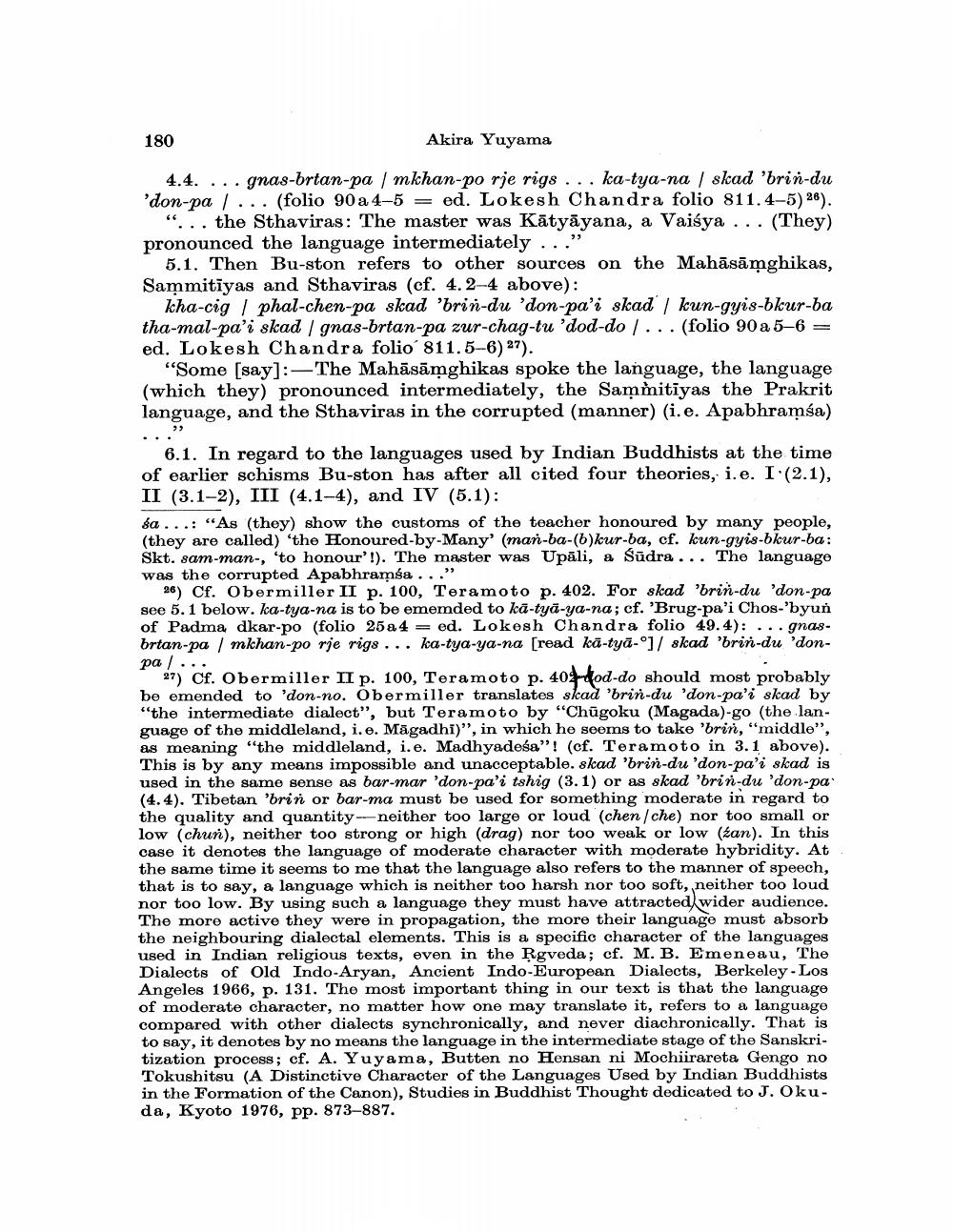________________
Akira Yuyama
4.4. gnas-brtan-pa / mkhan-po rje rigs... ka-tya-na / skad 'brin-du 'don-pa... (folio 90a4-5 ed. Lokesh Chandra folio 811.4-5)). “... the Sthaviras: The master was Katyāyana, a Vaiśya ... (They) pronounced the language intermediately...
33
5.1. Then Bu-ston refers to other sources on the Mahāsāmghikas, Sammitiyas and Sthaviras (cf. 4.2-4 above):
kha-cig phal-chen-pa skad 'brin-du 'don-pa's skad kun-gyis-bkur-ba tha-mal-pa'i skad / gnas-brtan-pa zur-chag-tu 'dod-do ... (folio 90a5-6ed. Lokesh Chandra folio 811.5-6) 7).
180
"Some [say]:-The Mahāsāmghikas spoke the language, the language (which they) pronounced intermediately, the Sammitiyas the Prakrit language, and the Sthaviras in the corrupted (manner) (i.e. Apabhramsa)
دو
6.1. In regard to the languages used by Indian Buddhists at the time of earlier schisms Bu-ston has after all cited four theories, i. e. I (2.1), II (3.1-2), III (4.1-4), and IV (5.1):
sa... "As (they) show the customs of the teacher honoured by many people, (they are called) 'the Honoured-by-Many' (man-ba-(b)kur-ba, cf. kun-gyis-bkur-ba: Skt. sam-man-, 'to honour'!). The master was Upāli, a Śūdra... The language was the corrupted Apabhramsa..."
26) Cf. Obermiller II p. 100, Teramoto p. 402. For skad 'brin-du 'don-pa see 5.1 below. ka-tya-na is to be ememded to kā-tya-ya-na; cf. 'Brug-pa'i Chos-'byun of Padma dkar-po (folio 25a4 ed. Lokesh Chandra folio 49.4): ... gnasbrtan-pa mkhan-po rje rigs... ka-tya-ya-na [read kā-tyā-°]/ skad 'brin-du 'donpa/...
27) Cf. Obermiller II p. 100, Teramoto p. 404-od-do should most probably be emended to 'don-no. Obermiller translates skad 'brin-du 'don-pa'i skad by "the intermediate dialect", but Teramoto by "Chugoku (Magada)-go (the language of the middleland, i. e. Magadhi)", in which he seems to take 'brin, "middle", as meaning "the middleland, i.e. Madhyadeśa"! (cf. Teramoto in 3.1 above). This is by any means impossible and unacceptable. skad 'brin-du 'don-pa'i skad is used in the same sense as bar-mar 'don-pa'i tshig (3.1) or as skad 'brin-du 'don-pa (4.4). Tibetan 'brin or bar-ma must be used for something moderate in regard to the quality and quantity-neither too large or loud (chen/ che) nor too small or low (chun), neither too strong or high (drag) nor too weak or low (zan). In this case it denotes the language of moderate character with moderate hybridity. At the same time it seems to me that the language also refers to the manner of speech, that is to say, a language which is neither too harsh nor too soft, neither too loud nor too low. By using such a language they must have attracted wider audience. The more active they were in propagation, the more their language must absorb the neighbouring dialectal elements. This is a specific character of the languages used in Indian religious texts, even in the Rgveda; cf. M. B. Emeneau, The Dialects of Old Indo-Aryan, Ancient Indo-European Dialects, Berkeley-Los Angeles 1966, p. 131. The most important thing in our text is that the language of moderate character, no matter how one may translate it, refers to a language compared with other dialects synchronically, and never diachronically. That is to say, it denotes by no means the language in the intermediate stage of the Sanskritization process; cf. A. Yuyama, Butten no Hensan ni Mochiirareta Gengo no Tokushitsu (A Distinctive Character of the Languages Used by Indian Buddhists in the Formation of the Canon), Studies in Buddhist Thought dedicated to J. Okuda, Kyoto 1976, pp. 873-887.
=




